 |
By Greg Hupé
(Meteorite Times, June 1, 2011)
|
|
“Is this a meteorite?” This is the first thought I silently spoke to myself as I examined a
particular greenish stone that was devoid of any apparent crust or other telltale signs of
being meteoritic. Other than a 2cm ‘patch’ of what appeared to be remnant fusion crust, I
could not be certain this rock was a meteorite. It resembled a diogenite, but a very strange
one if it was indeed a meteorite. Always on the lookout for the strangest of new meteorites, I
took a gamble and purchased the nearly half kilo stone and placed it in a bag and headed out the door.
Let me rewind a couple of days...
|
|

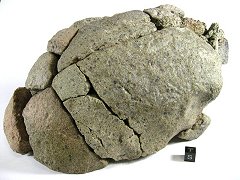
NWA 6704 meteortie - Reassembled mass (27cm x 16cm x 14cm).
|
It was once again time to make plans to attend the yearly Tucson Mineral Show, in this case, 2011. I
decided to arrive early this year so I could be among the first to examine material that a variety of dealers
would have to offer. Upon arriving at the show and making the rounds, it seemed that it was not meant to
be as I would find out that I was the second, third or even fourth person to pick through the boxes of new
arrivals. Aside from purchasing a few known meteorites, I was beginning to feel discouraged. I had one last
chance to score something interesting; a Moroccan friend of mine had not received his shipment of material
due to some unknown customs concerns. He assured me that he would let me be the first to open the boxes
when they were due to arrive the next day. We made arrangements for him to call me the next afternoon when
the shipment arrived.
The next day seemed to start off at a snail’s pace. The morning was bitter cold and as the hours came and
went, I received no calls from my friend so I drove by his hotel showroom several times throughout the day.
No activity, no one there, just an empty room. I was beginning to think he was somehow apprehended along
with his material and was being held somewhere — customs concerns I mused? Returning to my own hotel room
later that night, I made
|
|

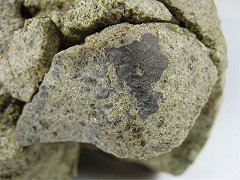
Close-up of fusion crust ‘patch’ on NWA 6704 (measures 1.2cm x 2cm).
|
|
one last call at 10:30 PM and was delighted when he answered. He said he received
his shipment late that afternoon and that we could meet early the next morning so I could be the first to
open the boxes with him. I hung up and went to bed anticipating an early start.
Sleep wasn’t meant to last and I was awake at 5:00 AM thinking of what I might discover in my friend’s
shipment. Getting anxious, I called him at 7:00 AM. He answered in a sleepy voice and was surprised that
I called so early. We made arrangements to meet at 8:30, giving him only an hour and half to wake up and
get ready for our meeting. Not wanting to chance anyone getting to the boxes before I did, I drove over
to his room to stake out my claim like a guard dog. As I walked towards his room, I spotted him in
another room with
|
a group of Moroccans sipping their morning tea. He waved me over and said lets go over
and start opening some boxes. I suggested he finish his breakfast since I not only woke him up early, I
was now interrupting his tea. He reassured me it was OK so we went to his room.
|
|
We dug into the boxes on the floor that were still sealed and I was presented
with a number of stones that I quickly examined and put in separate groups — some I was interested in, some
not so much. Only 20 minutes into my examination of this material, a fellow meteorite collector appeared in
the doorway and said he was there for his 9:00 AM “meeting” to look at the meteorites. I said I would be a
little while and that he should go have some breakfast and come back in about an hour. It didn’t work and he
continued to stand there hoping to jump in and start examining anything I was not interested in. Since he
was a friend of mine, I reassured him that he would be the next to check out the stones and that I wanted to
continue unpressured. He understood that I was politely asking him to leave and said he would be back in
about an hour. My Moroccan friend then closed and locked the door and shut the curtains so I could continue
without interruption. Sometime later I could hear that he was back at the door and talking with someone else
who must also have been waiting to gain entry into the room. Undaunted, I continued to examine every stone,
picking out anything I knew to be a rare meteorite or a suspect one worth gambling on.
|
Finished, I opened the door three hours later to find a small line of patient friends waiting. I felt a
little guilty about using so much time, but at least I was the first to go through the boxes and purchase
anything I thought was interesting. I would later find out just how special one of them would be!
|
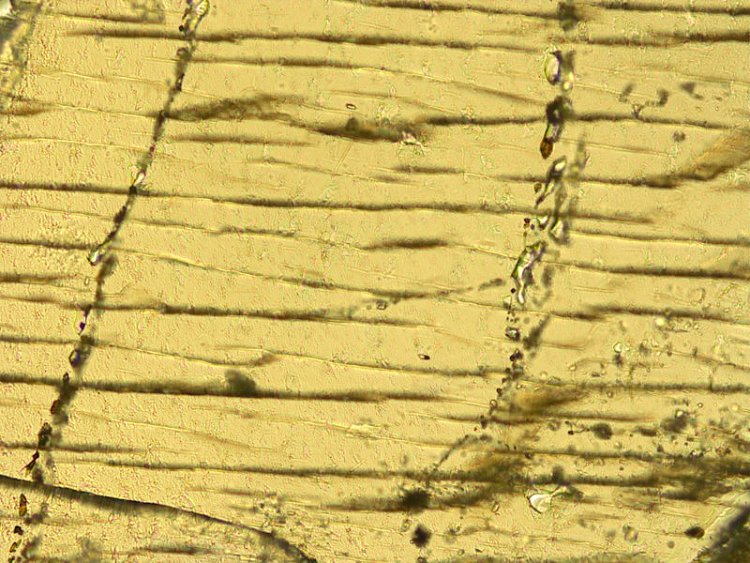
Bubble trains and cleavages in orthopyroxene (width of field 0.593 mm) (image courtesy Tony Irving and Nick Castle).
|
Not wanting to wait until I returned home two weeks later to send a sample for analysis, I immediately
shipped a piece of the odd greenish rock to Dr. Tony Irving at the University of Washington. He said he
would be able to examine it as soon as he received it since his workload was light at that moment. In the
two weeks that I was still in Arizona, Tony had received the sample and made a thin section to examine in
the electron microprobe lab. Initial analysis could not confirm one way or another what this stone might
be, not even if it was actually a meteorite or not. He said it would require oxygen isotope analysis to
determine what it was. I was having a feeling I may have purchased a terrestrial mantle xenolith and was
not feeling good about my expensive decision to acquire it. He said that the regular scientist who
performs this specialized analysis in Washington DC was out of the country for three months. He was
referred to another lab in Japan that could study the sample within a week of receiving it.
“Wow, that is amazing!” is all I could say and was extremely impressed with Dr. Irving’s network of
specialists who are able and willing to study strange material at a moment’s notice. As it turns out,
it was just very lucky timing — normally it takes months or years to get this type of work accomplished!
As promised, within a week of receiving the sample, the Japanese specialist confirmed the stone was
indeed a meteorite... but NOT a diogenite!!
|
Two days after returning home in Florida, I received a package of samples from a different Moroccan
partner. To my amazement, one of the samples looked similar to the odd green stone I had sent to Dr.
Irving while I was in Tucson. I sent the sample by overnight express to Tony and he said he believed
the sample was the same. I called my Moroccan friend and was told there was a 2-kilo stone in Algeria.
After a day of back-and-forth negotiating a price with the Algerian owner, he drove three days to a
meeting place along the southern borders of Morocco and Algeria. He told me the Algerian did not keep
his promise to sell him the stone and in turn sold it to a different Moroccan dealer in northern
Morocco for a few extra bucks. “Crap!” was all I could say out loud — well, in reality it was the
more extreme version of the phrase I choose not to use here!
|
Knowing there was precious little time to try and find the new ‘owner’ of the 2-kilo piece in northern
Morocco, I called the same friend who I purchased the 490-gram piece from in Tucson since he lived in
the northern region. Luckily he was back in Morocco and agreed to ask around about the stone trying not
to draw too much attention to it. It is all too often that word gets out and it becomes impossible to
get what you are after at a fair price, or ever at all. A few hours later he called back and said he
had actually found the person who had it and made arrangements to meet and possibly buy the stone. Two
days later, we were able to agree on an acceptable price. Prize in hand, he shipped it to me the next
day. I received it three days later, it was definitely the same!
|
|
And then there was more...
|
|
After a few days, my friend called again and said he heard that a single, broken stone weighing
around eight kilos had been distributed by the Algerian finders. He went on to say that some of the
larger pieces and been purposely broken just to see what was ‘inside’ the stone. Over the next few
weeks after receiving the 2-kilo stone, I was called
|

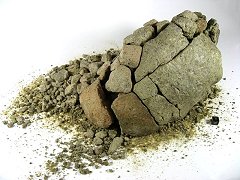
NWA 6704 assembled mass with carefully collected smaller fragments.
|
|
several times with “more” and then “even more”
pieces. I was beginning to think I got totally suckered as I was purchasing more and more of this
material, every time being told it was all from a single stone. I was reassured at each shipment
that there was one stone that had been broken apart and distributed to a few dealers in Morocco.
After the first three shipments, I was finally able to start putting the ‘puzzle’ stone back together,
or as I started to say, “I am starting to put Humpty Dumpty back together!” I was feeling better
about buying all pieces that surfaced.
It took four months of secrecy among a small group of friends, a lot of stress and a small fortune
to acquire this material on my part, and the expertise of several dedicated scientists, but the pieces
finally fell in place. Thinking
|
back at the time of purchasing the original 490-gram piece in Tucson
with just 20 minutes to spare, I feel this meteorite was meant for me to help discover and put back
together after being separated in Algeria. While there has been a substantial amount of scientific
discovery already made on Northwest Africa 6704 (NWA 6704), there is so much more that specialists
around the world will bring to light in the coming months and years. Stay tuned...
|
|
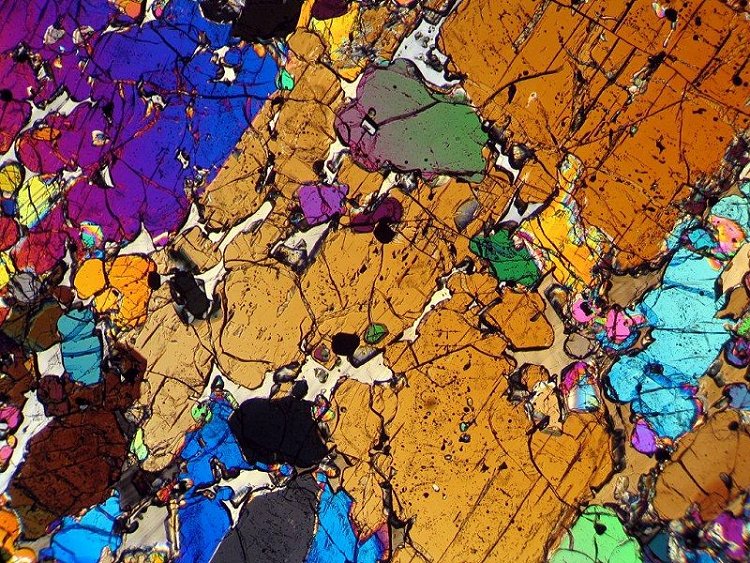
Optical thin section image of NWA 6704 taken in cross-polarized light. Large grains (brown, blue, and black along top) are orthopyroxene; smaller grains (mostly green and purple) are olivine; small opaque (black) grains are chromite and awaruite; and pale gray material between other grains is albite. Width of field is 5 mm. (photo courtesy John Kashuba).
|
Without attempting to describe the work performed by the dedicated scientists, I present here a
summary of analysis that have been performed as of the writing of this article (June 1, 2011):
|
|
Abstract submitted for the Meteoritical Society Meeting in London 2011:
NORTHWEST AFRICA 6704: A UNIQUE CUMULATE PERMAFIC ACHONDRITE CONTAINING SODIC FELDSPAR, AWARUITE AND “FLUID” INCLUSIONS, WITH AN OXYGEN ISOTOPIC COMPOSITION IN THE ACAPULCOITE-LODRANITE FIELD.
A. J. Irving1, R. Tanaka2, A. Steele3, S. M. Kuehner1, T. E. Bunch4, J. H. Wittke4 and G. M. Hupé. 1Dept. of Earth & Space Sciences, University of Washington, Seattle, WA 98195, irving@ess.washington.edu; 2Institute for Study of Earth’s Interior, Okayama University, Misasa, Japan; 3Geophysical Laboratory, Carnegie Institution, Washington, DC; 4Geology Program, SESES, Northern Arizona University, Flagstaff, AZ.
Petrography: A very fresh, dense, yellowish-green stone with rounded, shiny exterior surfaces and small patches of remnant
black fusion crust found in Algeria is a unique, medium grained (gs 0.3-1.5 mm), unshocked achondrite with an igneous cumulate texture.
Smaller grains of olivine (Fa51.6-53.2; FeO/MnO = 120-140; NiO = 0.9-1.0 wt.%) and chromite [Cr/(Cr+Al) = 89.0) are enclosed within large (up to 1.5 mm) orthopyroxene oikocrysts (Fs41.6-42.4Wo2.8-3.6, FeO/MnO = 81-106), which are surrounded by intercumulus indistinctly-twinned, very sodic plagioclase (Ab92An4Or4) and tiny grains of awaruite (Ni = 75wt.%). Orthopyroxene grains contain curvilinear trains of tiny rounded to irregularly-shaped, clear to pinkish inclusions (<2-30 μm), which appear on polished
surfaces to be empty bubbles with smooth rounded walls. Confocal Raman spectroscopy of inclusions below thin section surfaces did not
reveal any fluid species.
Oxygen Isotopes: Replicate analyses of acid-washed bulk material by laser fluorination gave: δ17O 1.015, 0.880; δ18O 3.922, 3.613; Δ17O -1.048, -1.020 per mil., respectively.
These results plot in the field for acapulcoites and lodranites [1].
Discussion: This specimen is unlike any other known achondrite in its combined mineralogical features: mafic silicate minerals
with elevated FeO/MnO ratios, extremely sodic plagioclase, trapped bubble trains and very Ni-rich metal. Despite its oxygen isotopic
composition, NWA 6704 bears no mineralogical resemblance to members of the acapulcoite-lodranite clan. It appears to be a cumulate
igneous rock related to an unknown “planetary” parent body, which evidently was capable of interior melting and crystal accumulation.
The relatively ferroan silicates, very sodic plagioclase and now empty (?)fluid inclusions (see below) suggest a somewhat “Earth-like”,
differentiated parent body.
References: [1] Clayton R. and Mayeda T. (1996) Geochim. Cosmochim. Acta 60, 1999-2017; Irving A. et al. (2007) Lunar Planet. Sci. XXXVIII, #1338.
|
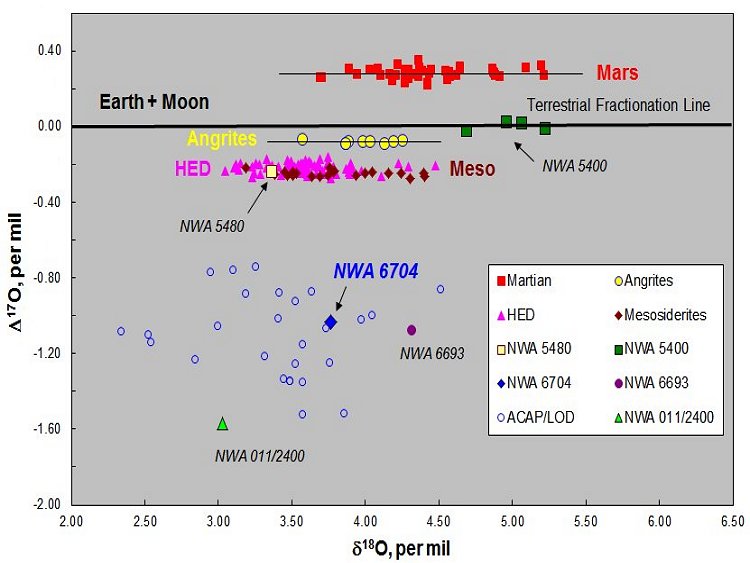
Oxygen isotopic compositions of various achondrites relative to the terrestrial fractionation line (TFL). NWA 6704 plots well below the TFL within the broad field for members of the acapulcoite-lodranite clan, and far from the fields for eucrites, diogenites and mesosiderites.
|
Officially accepted classification of NWA 6704 as entered in the Meteoritical Bulletin:
Northwest Africa 6704 (NWA 6704)
Algeria
Purchased: 2011 Feb-May
Classification: Ungrouped achondrite
History: A single, dense, yellowish-green stone was found in pieces in Algeria, and was purchased in February 2011 at the
Tucson Gem and Mineral Show and over subsequent weeks from Moroccan dealers by Greg Hupé.
Physical characteristics: Forty two pieces fit together as a single ovoid mass (8387 g) with rounded, shiny exterior and
small patches of remnant black fusion crust. The interior is mostly pale yellowish green with rare darker brownish grains and
sparsely distributed small grains of opaque oxide and metal.
Petrography: (A. Irving and S. Kuehner, UWS): Overall medium grained with an igneous cumulate texture. Small grains of olivine
(0.5-0.8 mm) and chromite (0.1-0.6 mm) enclosed within large (to 4 mm) orthopyroxene oikocrysts, which are in turn surrounded by large
optically continuous, intercumulus grains of untwinned albite and <0.1 mm awaruite. The silicates contain curvilinear trains of tiny
rounded inclusions (2-20 μm), which appear on polished surfaces to be empty bubbles with smooth rounded walls.
Geochemistry: Olivine (Fa51.6-53.2; FeO/MnO=120-140; NiO=0.9-1.0 wt.%), orthopyroxene (Fs41.6-42.4Wo2.8-3.6, FeO/MnO=81-82; Cr2O3=0.3 wt.%), plagioclase (Ab92-93An4-3Or4). Oxygen isotopes (R. Tanaka, OkaU): replicate analyses of acid-washed material by laser fluorination gave: δ17O 1.015, 0.880; δ18O 3.922, 3.613; Δ17O -1.048, -1.020 per mil.
Classification: Achondrite (ungrouped). This specimen is unlike other achondrites in its combined features: relatively ferroan
mafic silicate minerals with elevated FeO/MnO ratios and anomalous Ni contents, extremely sodic plagioclase, very Ni-rich metal, and
oxygen isotopic composition that plots within the field for acapulcoites-lodranites. Weathering is low and limited to minor coatings
of pale orange desert dust on broken surfaces. Unshocked.
Specimens: A total of 20.5 g of type material and two polished thin sections are on deposit at UWS. The remaining material
is held by Greg Hupé.
|
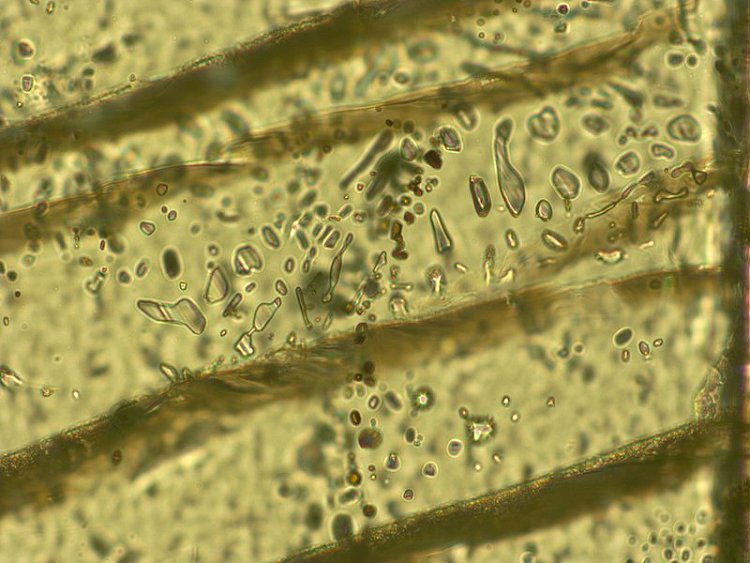
Close-up #2 of bubble trains within NWA 6704 (width of field 0.237mm) (image courtesy Tony Irving and Nick Castle).
|
|
NWA 6704 is a most intriguing meteorite unlike any others known to man! Not only does it have tremendous scientific value, it is one
of the most visually appealing meteorites with its dazzling display of yellowish-green orthopyroxene crystals containing small grains
of olivine and chromite surrounded by large intercumulus grains of albite enclosing small grains of awaruite (a rare very nickel-rich alloy).
Oxygen isotope results plot this achondrite within the field for acapulcoites-lodranites, but that is where any comparison stops.
NWA 6704 is unlike any other
|

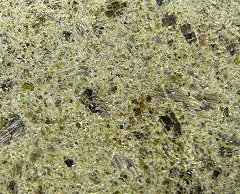
Close-up of the NWA 6704 matrix.
|
|
meteorite! If that isn’t enough, this incredible meteorite contains an abundance of ‘bubble trains’
within the orthopyroxene which appear to be void of fluid upon initial inspection. Ongoing analysis are currently being performed
to measure the cosmogenic noble gases to determine its CRE age (time spent in space) and to possibly detect trapped gases or even
atmosphere from the NWA 6704 parent body!
NWA 6704 weighs 8387 grams in a single, naturally fractured stone that was discovered in Northwest Africa in 2010.
In their eagerness to see what was ‘inside’ the stone, the Algerian finders unfortunately broke the largest pieces as can be seen in
the image of the reassembled stone above. Also visible are the natural breaks along extended grain boundaries which have been
|
sandblasted over time in the Sahara, smoothing the edges on the
largest pieces and a more ‘rounding’ of the smaller fragments.
Oddly, NWA 6704 is almost entirely devoid of visible fusion crust; only a single 1.5cm x 2cm patch exists, raising questions as
to how this can be. Through a determined effort over a four month period, the distributed parts were purchased by the author and
reassembled into a single stone resembling a ‘puzzle’. It is remarkable that the finders were able to collect even the smallest of
fragments as can be seen in the image above! I thought it would be a great way to emphasize the diligent recovery effort the Algerian
finders did to save practically every grain of this material... and to illustrate what it could have possibly looked like
in the wind swept Sahara when first viewed by human eyes!
|
|
Link to article as seen in Meteorite Times: www.meteorite-times.com/articles/nwa-6704-new-ungrouped-meteorite
|












